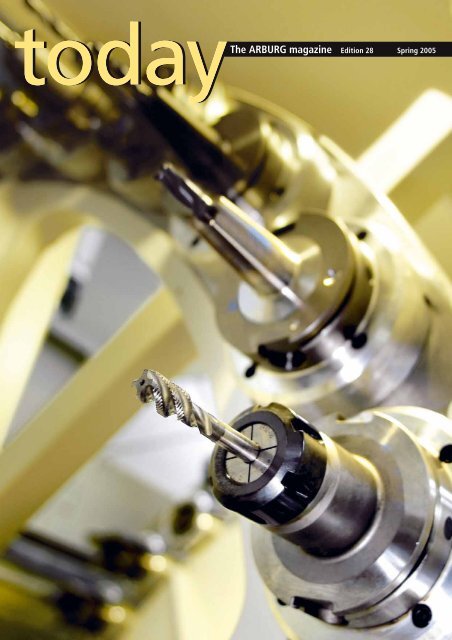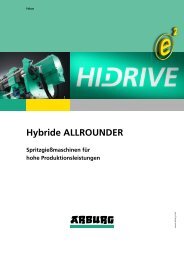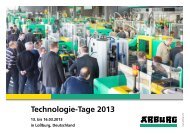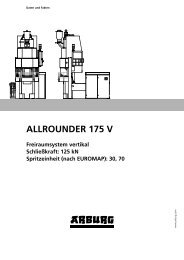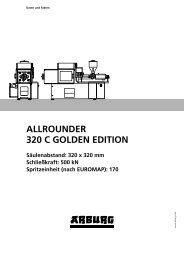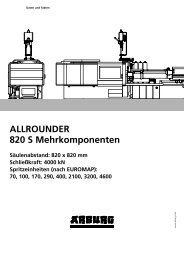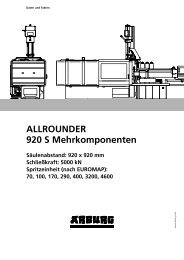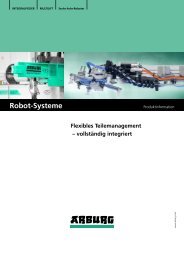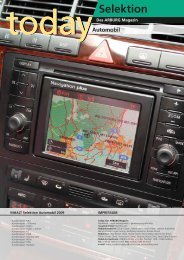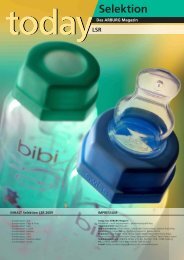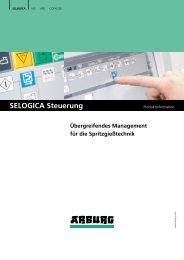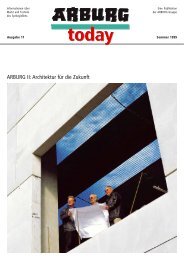GB - Arburg
GB - Arburg
GB - Arburg
Create successful ePaper yourself
Turn your PDF publications into a flip-book with our unique Google optimized e-Paper software.
today<br />
ARBURG magazine Edition 28 Spring 2005<br />
todayThe
CONTENTS<br />
4<br />
6<br />
8<br />
10<br />
12<br />
14<br />
16<br />
17<br />
18<br />
19<br />
MASTHEAD<br />
ARBURG internal events<br />
Generation change at the top<br />
K 2004<br />
Thoroughly successful exhibition<br />
Customer Report<br />
WERMA: A signal for success<br />
Co-operation<br />
Bayer MaterialScience: Testing times<br />
Projects<br />
One plus one for greater fl exibility<br />
Customer Report<br />
Ulstrup Plast: Three companies, one strong unit<br />
Service<br />
Strong together<br />
Product<br />
ECOnomical!<br />
History<br />
Milestones<br />
Tech Talk<br />
Adapted nozzle geometries<br />
“today“, the ARBURG magazine, Issue 28, Spring 2005<br />
Reproduction – even in part – only by express permission<br />
Responsible: Dr Christoph Schumacher<br />
Editorial Advisory Board: Juliane Hehl, Martin Hoyer, Bernd Schmid, Jürgen Schray,<br />
Wolfgang Umbrecht, Renate Würth Editorial Team: Uwe Becker (text), Markus Mertmann (photos),<br />
Vesna Sertić (photos) Susanne Wurst (text), Peter Zipfel (layout)<br />
Editorial address: ARBURG GmbH + Co KG, PO box 1109, 72286 Lossburg,<br />
Tel.: +49 (0) 7446 33-3149, Fax: +49 (0) 7446 33-3413,<br />
e-mail: today_kundenmagazin@arburg.com, www.arburg.com<br />
2<br />
today 28/2005<br />
The tool magazine of a machining centre.<br />
On these facilities, components such as plasticising<br />
cylinders are manufactured from the raw<br />
material in a single working step.
Dear<br />
readers,<br />
The time has arrived. Following a long and eventful working life<br />
in the service of our company and the idea of making plastic<br />
injection moulding utilisable allround, we have retired from our<br />
active executive duties as Chairpersons of the Management<br />
Board.<br />
After more than 50 years during which we, together with our<br />
customers, turned a tiny company into one of the global leaders<br />
among injection moulding machine manufacturers, we would<br />
like to thank all our companions – customers, co-operation<br />
partners and colleagues – for the decades of trust they have<br />
placed in us.<br />
We have grown together, never losing sight of customer contacts<br />
and market requirements, and with our small machines we have<br />
made it possible for many now successful companies to enter<br />
into the plastics processing business.<br />
As a manufacturer of technical appliances, we have always had<br />
the advantage of being able to approach the tasks and require-<br />
ments at hand from a perspective slightly different to that of<br />
conventional machine constructors.<br />
We thank you for this long and exciting period during which<br />
you have placed your trust in us.<br />
today 28/2005 3<br />
Karl Hehl Eugen Hehl<br />
EDITORIAL<br />
With long foresight to this generational succession, we have<br />
dutifully, continuously and systematically placed the executive<br />
responsibility into the hands of our children, who will pursue<br />
our “life‘s work“ under these maxims. Please place the same<br />
trust in them as you have allowed us to enjoy.<br />
The new grows out of the old. This step ensures the continu-<br />
ity of our family business in its familiar form – technologically<br />
innovative, customer-oriented, quality-conscious and always<br />
economically independent.<br />
We wish you all the best for the future and hope you enjoy<br />
reading our new edition of “today“!
ARBURG INTERNAL<br />
Generation change<br />
Tradition and innovation have always<br />
been the pillars supporting<br />
successful corporate development<br />
at ARBURG. These values have also underpinned<br />
the corporate management<br />
restructuring, which came into force<br />
on 1 January 2005. With Juliane Hehl,<br />
Renate Keinath and Michael Hehl, the<br />
third generation of the owning Hehl<br />
family have taken over direction of<br />
the company as managing partners in<br />
order to lead ARBURG into an innovative<br />
and dynamic future in collaboration<br />
with the managing directors. The<br />
former Chairpersons of the Management<br />
Board, Karl and Eugen Hehl, will<br />
take on advisory roles within this committee.<br />
Juliane and Michael Hehl, Eugen Hehl‘s<br />
children, have already worked in positions<br />
of responsibility in the company. Juliane<br />
Hehl will continue to be responsible for the<br />
company‘s Marketing division, which will be<br />
integrated into the upper management level<br />
with immediate effect. Partner Michael Hehl<br />
is now spokesperson for the management<br />
team and will be responsible for future plant<br />
development.<br />
Renate Keinath, the daughter of Karl Hehl,<br />
has taken on responsibility for the Human<br />
Resources division in her role as a Managing<br />
Partner. She already has a close association<br />
with the company due to her involvement in<br />
executive committees. Before assuming her<br />
new position, Renate Keinath worked in the<br />
teaching profession and adult education.<br />
An ideal prerequisite for successful personnel<br />
development at ARBURG.<br />
Furthermore, the corporate management<br />
structure has also been extended. After the<br />
ongoing expansion of the international sales<br />
network over the past four and a half years,<br />
the previous Managing Director of Sales and<br />
4<br />
Controlling, Michael Grandt will in future be<br />
concentrating more on the Accounts and Controlling<br />
division. He has therefore handed the<br />
management of the Sales division over to Helmut<br />
Heinson, who joined the company at the<br />
beginning of the year. Heinson has a wealth of<br />
today 28/2005<br />
experience in the fi eld of machine and plant<br />
construction.<br />
The ARBURG management team now consists<br />
of eight people, who have the following<br />
responsibilities: Michael Hehl (Spokesperson<br />
for the management team and responsible for
at the top<br />
plant development), Juliane Hehl (Marketing),<br />
Renate Keinath (Human Resources), Eugen<br />
Hehl (advisory role), Karl Hehl (advisory role),<br />
Michael Grandt (Accounts and Controlling),<br />
Herbert Kraibühler (Technical Department),<br />
Helmut Heinson (Sales).<br />
With this forward-thinking move ARBURG<br />
has secured the independent, self-determining<br />
development of the family business on a<br />
long-term basis. Innovation will thus continue<br />
to be the tradition at ARBURG.<br />
today 28/2005 5<br />
ARBURG INTERNAL<br />
The ARBURG management team (from left to right):<br />
Helmut Heinson, Michael Grandt, Herbert Kraibühler,<br />
Juliane Hehl, Michael Hehl, Renate Keinath,<br />
Karl Hehl and Eugen Hehl.
Thoroughly successful<br />
ARBURG‘s presence at the K 2004<br />
was an allround success. “We‘re<br />
more than satisfi ed. It was an excellent<br />
K trade fair with many high-quality<br />
contacts –, great business and very<br />
good prospects for excellent follow-up<br />
trade,“ was how ARBURG summed it<br />
up. The exhibits with the new features<br />
and the innovative applications drew a<br />
great deal of attention as did the mime<br />
artists.<br />
The way to ARBURG in Hall 13, Stand A 13<br />
was easy to fi nd thanks to this special communication<br />
concept. All you had to do was follow<br />
the mime artists, which were present everywhere.<br />
From the International Arrivals terminal<br />
A at Düsseldorf Airport and advertising hoardings<br />
outside the trade fair centre through to the<br />
“real life“ mime artists on the stand.<br />
On all eight days of the fair, crowds gathered<br />
at the large two-storey exhibition stand,<br />
which covered some 1,100 square meters. The<br />
great interest shown by the trade visitors was a<br />
6<br />
clear indication that the right choice had been<br />
made with the ten machine exhibits and the<br />
interesting applications. In addition to three<br />
innovative products, the ALLROUNDER 320 A,<br />
ALLROUNDER 270 U and alternative “SELOGICA<br />
direct“ control system, the complete production<br />
cells and various multi-component applications<br />
proved to be real crowd-pullers.<br />
A smaller machine has been added to the<br />
electric ALLDRIVE series in the form of the<br />
new ALLROUNDER 320 A. As a result, the<br />
ALLROUNDER A models, the electric axes of<br />
which can be combined with electric or hydraulic<br />
auxiliary axes, are now available in a clamping<br />
force range from 500 kN to 2000 kN.<br />
Following on from the ALLROUNDER 170 U,<br />
ARBURG introduced a second fully-hydraulic<br />
small injection-moulding machine onto the<br />
market, the ALLROUNDER 270 U. The abbreviation<br />
“U“ stands for the universal application of<br />
this machine. The key data for the new 270 U,<br />
are a distance of 270 millimetres between tie<br />
bars and clamping forces of 250 kN, 350 kN<br />
and 400 kN. The centrally arranged clamping<br />
today 28/2005<br />
system of the ALLROUNDER U ensures symmetrical<br />
force characteristics of the mould<br />
clamping unit, guaranteeing maximum precision.<br />
The hydraulic system being in close proximity<br />
to where is it needed on both the injection<br />
and clamping sides, also ensures optimum<br />
control of the drive axes, resulting in the highest<br />
accuracy.<br />
The third innovation was the new alternative<br />
“SELOGICA direct“ control system with a<br />
15-inch touchscreen. Fast and effective navigation<br />
is possible by touching the appropri-
ate element on the screen, making data entry<br />
and control of the machine and peripherals<br />
even simpler and more user-friendly. The new<br />
“SELOGICA direct“ user interface will not replace<br />
the previous SELOGICA, but represents<br />
an alternative to it. The “SELOGICA direct“<br />
was not only demonstrated on the two new<br />
ALLROUNDERs at the K, it was also tested extensively<br />
on simulators.<br />
Multi-component injection moulding<br />
dominated the applications. The well-known<br />
ARBURG briefcase was moulded on a twocomponent<br />
version of the large ALLROUNDER<br />
820 S. The fully automatic assembly of the<br />
case was an innovation which provided the<br />
Project Department an opportunity to demonstrate<br />
their work. The production cell on which<br />
the sought-after table-tennis bat was made<br />
exhibition<br />
today 28/2005 7<br />
K 2004<br />
Ever present: the mime artists at the<br />
well-visited ARBURG exhibition stand.<br />
The exhibits attracted the attention of the international<br />
trade visitors and received close examination.<br />
First ARBURG machine as cult object<br />
It was not only innovations<br />
which were presented at<br />
the K, but also a real cult<br />
object from the fi fties: the fi rst<br />
ever ARBURG injection moulding<br />
machine.<br />
The original ARBURG machine – painted<br />
in the modern, current ARBURG colours be-<br />
from ABS and TPE also came from the Project<br />
Department. Its centrepiece is an ALLROUNDER<br />
630 S with a three-station rotary mould and a<br />
MULITILIFT robotic system which removes the<br />
fi nished bat halves from the third open mould<br />
station. The halves are welded ultrasonically<br />
during a further stage of the process.<br />
The complete production of a sealing<br />
diaphragm made from PA and LSR was demonstrated<br />
on a facility with an ALLROUNDER<br />
570 C, which was made available by Rico,<br />
ARBURG‘s long-standing co-operation partner<br />
for LSR applications.<br />
longs to the collection of<br />
DITTRICH + Co, the compression<br />
moulds are from the collection<br />
of C. HÜBNER GmbH.<br />
Under the motto “Mould a cult“<br />
visitors to these two companies´ exhibition<br />
stand were able to mould four limited cult symbols<br />
from the fi fties, sixties and seventies as a<br />
souvenir in plastic.
CUSTOMER REPORT<br />
Blinking, fl ashing,<br />
hooting and even<br />
sending text messages,<br />
– all this can be done<br />
by the products of WERMA<br />
Signaltechnik, the market<br />
leader in signalling devices.<br />
The company has been operating<br />
successfully in this market<br />
for over 50 years and has<br />
always been one step ahead of<br />
the competition thanks to its<br />
futuristic and customer-orientated<br />
innovations. WERMA products<br />
are used around the world in<br />
all sectors. ARBURG machines are<br />
equipped with WERMA signal beacons,<br />
the components of which are,<br />
in turn, produced on ALLROUNDERs.<br />
WERMA Signaltechnik was established by<br />
Werner Marquardt in Rietheim in 1950. Their<br />
fi rst product was a new type of hairdryer. The<br />
range was quickly extended to include time<br />
switches, before the company turned its attention<br />
to signalling technology with buzzers and<br />
horns, a fi eld in which it remains successful to<br />
this day.<br />
According to its corporate philosophy,<br />
8<br />
WERMA pursues the goal of<br />
“ensuring the safety and<br />
orientation of people in an<br />
automated world regardless<br />
of language through<br />
the use of clear optical and<br />
acoustic signals.“ For this<br />
purpose, WERMA offers a<br />
product range which includes<br />
some 2400 products<br />
divided into three<br />
areas, optical, acoustic<br />
and combined signalling<br />
technology.<br />
Germany is the<br />
company‘s principal<br />
market, accounting<br />
for 65% of sales, although<br />
signifi cantly<br />
more WERMA<br />
products are in<br />
use world-wide<br />
through the export<br />
of customer<br />
products. The company<br />
co-operates with 30 trading partners in the<br />
export sector, which are regularly invited to attend<br />
product training sessions in Rietheim.<br />
One of WERMA‘s guidelines is to only de-<br />
today 28/2005<br />
A signal for<br />
velop and market products which are genuine<br />
innovations. Thus, the company achieves<br />
around a third of its sales with products introduced<br />
onto the market within the previous fi ve<br />
years. The success of this strategy is evidenced<br />
by increases in sales of between 10 and 20 per<br />
cent in recent years. In 2004 sales amounted to<br />
some 17 million euros.<br />
A further guarantee for success are the 150<br />
employees which make up a strong team. The<br />
15 employees in the development department,<br />
for instance, work closely with their colleagues<br />
from the other departments. During workshops,<br />
new trends are jointly identifi ed and solutions<br />
developed in line with market requirements.<br />
Absolute priority is always awarded to<br />
user benefi ts and customer satisfaction.<br />
“As leaders in technology, we owe it to our<br />
customers to set new trends.“ says Managing<br />
Director, Günter Kirn. In order to keep ahead of<br />
its competitors, WERMA invests about ten per<br />
cent of its costs in development and launches<br />
many new products on the market every year.<br />
Among the approximately 15 innovations to<br />
be unveiled in 2005 is the GSM transmitter element<br />
which will be used to upgrade the CombiSIGN<br />
signal tower. In the event of a machine<br />
malfunction, the GSM transmitter element<br />
sends a text message to up to 3 mobile phones.
success<br />
Furthermore, the current machine status can<br />
also be checked via mobile phone at all times.<br />
It is not only individual signal towers which can<br />
be equipped with this module. It can also be<br />
fl exibly exchanged among various machines.<br />
“Competition is clearly driven by price in our<br />
sector today,“ comments Günther Kirn. “Consequently,<br />
we have to produce cost-effectively at<br />
the highest quality level.“<br />
“Production is the core of our competence“<br />
says Production Manager, Erich Martin. “We aim<br />
to develop and produce plastic parts in-house<br />
which perform as many different functions as<br />
possible and to produce them with a high degree<br />
of vertical integration.“<br />
Correspondingly, some 200 complex moulds<br />
work partly using hot runner systems. Many of<br />
the moulds are chrome-nickel coated as fi bre<br />
glass-reinforced plastics are processed among<br />
other materials. WERMA ensures the quality of<br />
its moulds, and consequently of its products, by<br />
constructing its moulds in-house.<br />
In production terms, WERMA has relied<br />
on ARBURG technology from the outset. Its<br />
fi rst machine dates back to 1964 when the<br />
company began to processes thermoplastics<br />
as well as thermosets. It currently has nine<br />
ALLROUNDERs in operation in its modern production<br />
hall, with a clamping force range from<br />
150 to 1300 kN; the monthly injection moulding<br />
output is between 200,000 and 300,000<br />
parts, with batch sizes of between 50 and<br />
10,000 units. Immediately next to the injection<br />
moulding plant is the assembly area, where the<br />
components are assembled, installed, checked<br />
and the fi nished products are packaged.<br />
As all the ALLROUNDERs have been<br />
equipped with WERMA signal towers for<br />
over ten years, ARBURG is both supplier<br />
and customer. Through its production using<br />
ALLROUNDERs, WERMA knows which of<br />
its own developments may be of interest to<br />
injection moulding companies, such as the<br />
new GSM transmitter module which ARBURG<br />
is adding to its range.<br />
today 28/2005 9<br />
INFOBOX<br />
CUSTOMER REPORT<br />
Photos: WERMA<br />
Left page: WERMA signal towers can be fl exibly combined<br />
with regard to both colour and function.<br />
The GSM radio module is new to the range.<br />
Right page: modern machines in the injection moulding<br />
plant and in-house mould construction ensure the quality<br />
of WERMA products, which are also utilised during<br />
in-house production, for instance the<br />
signal towers on the ALLROUNDERs.<br />
Founded: 1950<br />
Production area: 10,000 m²<br />
Employees: 150<br />
Sales: 17 million (2004); annual increase<br />
between 10 and 20 per cent<br />
Products: Optical, acoustic and combined<br />
signalling devices<br />
Machine fl eet: nine ALLROUNDERs with<br />
clamping forces from 150 to 1300 kN<br />
Contact: WERMA Signaltechnik<br />
GmbH + Co. KG, D-78604 Rietheim<br />
www.werma.de
Testing times<br />
When it comes to material<br />
tests, the very best equipment<br />
is required to make<br />
well-founded quality assessments.<br />
Consequently, there are approximately<br />
20 ALLROUNDER injection-moulding<br />
machines at the Thermoplastics Testing<br />
Centre (TTC) at Bayer Material Science<br />
AG in Krefeld.<br />
The close co-operation is clearly evidenced<br />
in the TTC‘s latest image video which<br />
names ARBURG as a partner. A total of<br />
18 ALLROUNDERs, predominantly C and Sseries<br />
machines, are in use at the TTC, which<br />
covers a total area of 4200 m². They are used<br />
exclusively for the production of so-called test<br />
samples and plates which are produced in<br />
order to perform a wide range of different quality<br />
tests. Stated bluntly, the ALLROUNDERs are<br />
used mainly to produce parts which are immediately<br />
destroyed again.<br />
This also explains what the main function<br />
of the TTC is, both internally within Bayer and<br />
as a profi t centre for all external customers<br />
worldwide. In order to effectively assure the<br />
quality of plastics and plastic parts, they must<br />
be loaded to the limits and beyond. However,<br />
in addition to producing samples and confi -<br />
dentially carrying out 175 standard and further<br />
individual special tests, the TTC‘s `all-inclusive<br />
service‘ also includes the compounding of<br />
standard polymers and technical thermoplastics<br />
in small batches, as well as consulting in the<br />
fi eld of testing technology. Major customers<br />
are also able to transmit the composition<br />
of their material samples via a network<br />
connection and the granulate to be<br />
tested is then produced from a<br />
store of components. Virtually all ISO, CAM-<br />
PUS, ASTM and UL tests (a range available nowhere<br />
else) can be conducted using approximately<br />
100 sample moulds. Using the BMS<br />
mould control system, important process data<br />
is determined during the injection moulding<br />
process and referred to for the<br />
purposes of quality evaluation.<br />
The range of services provided<br />
is completed by the testing of<br />
fi nished or semi-fi nished parts,<br />
the production of optical-quality<br />
plastic plates, weathering<br />
tests, as well as analysis of the<br />
effects of surface treatments<br />
on polymers. Their testingtechnology<br />
consulting activities<br />
extend to the assembly, supply<br />
and setting up of complete testing<br />
centres.<br />
Many of the ARBURG machines used at<br />
the TTC feature high levels of automation and<br />
autonomy, as are required for 24 hour production<br />
and testing. A good example is the four<br />
ALLROUNDER 370 C 800-250 production cells<br />
with 3-axis NC robots. Following part removal<br />
from the moulds, the sprues are cut off in a<br />
downstream processing station, and the samples<br />
are then fed to a fi lm packaging station<br />
which separates them according to test runs.<br />
The different mould inserts can be exchanged<br />
automatically using a special insert changer.<br />
Experts from TTC will be making a presentation<br />
of their own as part of the fringe programme at<br />
the 2005 ARBURG Technology Days.<br />
today 28/2005 11<br />
INFOBOX<br />
CO-OPERATION<br />
Co-operation between the TTC and ARBURG has been<br />
stepped up steadily over the years. For example, ARBURG is<br />
also supplying ALLROUNDER injection-moulding machines<br />
for the new production facility in China.<br />
Contact: Bayer MaterialScience AG<br />
Thermoplastics Testing Centre<br />
Werk Uerdingen, Gebäude R 33<br />
Rheinuferstraße 7-9, D-47829 Krefeld<br />
www.ttc.bayermaterialscience.com<br />
Photos: Bayer
One plus one for<br />
12<br />
today 28/2005<br />
Parts consisting of multiple<br />
components cannot only be<br />
produced on multi-component<br />
machines. The reasons for producing<br />
multi-component moulded parts<br />
on two machines are as varied as the<br />
range of parts produced in this sector.<br />
The Project Department at ARBURG<br />
can provide assistance with alternative<br />
concepts.<br />
The alternatives to classical multi-component<br />
injection moulding range from the integration<br />
of intermediate processing steps in<br />
the production process and the use of special<br />
mould technology through to the further use<br />
of existing moulds.<br />
The intermediate processing of injectionmoulded<br />
parts in particular entails very different<br />
operations which may best be performed<br />
using several injection-moulding machines and<br />
robotic systems. For example, the pre-moulded<br />
part may have to be cooled, or the moulded<br />
part re-worked. The range of operations includes<br />
sprue separation, contact separation,<br />
deburring or the assembly of components, as<br />
well as the re-orientation of parts between the<br />
pre-injection and encapsulation station, and<br />
visual or dimensional quality checks on premoulded<br />
parts.<br />
However, different mould temperatures,<br />
such as those required for the combined processing<br />
of thermoplastics and LSR, may also create<br />
the need for part production in two moulds<br />
and for automatic transfer via robotic systems.<br />
Ultimately, however, part requirements which<br />
create the need for complex mould technology<br />
(core pulls, mechanical side cores, unscrewing<br />
units, pneumatically-operated axes, etc.) and<br />
different cavity confi gurations are also reasons<br />
for splitting production between two machines<br />
with automated handling processes.<br />
All the concepts which the Project Depart-
greater fl exibility<br />
ment at ARBURG has realised for these types<br />
of tasks are primarily based on two principles.<br />
Either two ALLROUNDERs are linked together<br />
via a MULTILIFT V robotic system, or two machines<br />
are used in conjunction with two directly<br />
assigned robots. These, in turn, can be<br />
linked together in different ways. The simplest<br />
confi guration: robot 1 places the pre-moulded<br />
parts onto an intermediate table, robot 2 picks<br />
them up and places them into the second<br />
ALLROUNDER for fi nal injection moulding. This<br />
type of combined operation is also possible via<br />
a central sliding table which both robots work<br />
from. In this case the machines stand back-toback.<br />
Another alternative: a conveyor section<br />
which transports the pre-moulded parts from<br />
machine 1 to machine 2. This permits a fl exible<br />
machine confi guration. Various setup options<br />
(back-to-back or in line) can be implemented,<br />
whereby the production cell can be expanded<br />
at any time.<br />
Furthermore, this creates a buffer between<br />
the ALLROUNDERs for separating production<br />
steps. The advantage of the solution involving<br />
two ALLROUNDERs and two robotic systems<br />
is that applications can be implemented more<br />
fl exibly. This system enables the two machines<br />
to be separated functionally at any time in the<br />
event, for example, of changes in<br />
production requirements.<br />
A typical application for a<br />
system confi guration with<br />
a central robot is the inmould<br />
laminating of fi lm.<br />
The process sequence is as<br />
follows: fi rst, the fi lms provided<br />
are separated, centred<br />
and cleaned by the robot before<br />
being inserted into the mould on<br />
the fi rst machine. The pre-moulded<br />
parts are created here. They are removed<br />
again by the robot and processed<br />
on a cutting station. The robotic system<br />
then picks the parts up again and places them<br />
in the second machine where they undergo<br />
fi nal injection moulding with another component.<br />
Following removal of the fi nished parts,<br />
the robot places these onto a conveyor belt<br />
for downstream processing.<br />
today 28/2005 13<br />
PROJECTS<br />
Production solutions developed outside the standard<br />
machine range and supported through to fi nal use<br />
(illustrations at top and bottom) are implemented by the<br />
ARBURG project department. Here, fl exible production<br />
cells are created which can be adapted precisely to<br />
companies‘ individual processing requirements in<br />
accordance with the relevant market demands.
Three companies,<br />
Today, many companies in the<br />
plastics sector style themselves<br />
as system suppliers. However,<br />
very few of them actually succeed in<br />
living up to this claim due to the lack<br />
of the comprehensive expertise necessary<br />
for the task. Ulstrup Denmark<br />
is a system supplier. As a result of the<br />
merger between Ulstrup Plast, Scan<br />
Tools and Svanemose, three suppliers<br />
have united to form a single competent<br />
system supplier offering its customers<br />
expert support from the drawing<br />
board through to the packaging of<br />
the plastic parts.<br />
At the three Ulstrup Plast A/S production<br />
sites resulting from the merger, all located in the<br />
Greater Copenhagen area, a total of 60 injectionmoulding<br />
machines are in action, predominantly<br />
producing parts for industrial applications, the<br />
telecommunications and medical technology<br />
sectors. Twenty-fi ve of these 60 machines are<br />
recent ARBURG ALLROUNDER models less than<br />
eight years old.<br />
The company‘s main activities are in the<br />
fi elds of high-precision two-component injection-moulded<br />
parts and clean-room production.<br />
At the Ulstrup premises, facilities are available<br />
for the manufacture of clean-room products<br />
meeting all the requirements of the medical<br />
technology sector. One way in which the company<br />
lives up to its philosophy of allround support<br />
for its customers is by operating its own<br />
mould construction facility which is able to supply<br />
high-precision moulds on the dot.<br />
In the future, the company consequently<br />
aims to concentrate on the validation of machines<br />
and moulds in the fi eld of clean-room<br />
and two-component production. The automated<br />
production of inserts could also become a<br />
core business area.
one strong unit<br />
Ulstrup Plast is exclusively a sub-supplier<br />
and manufactures its components primarily for<br />
the Danish and European market. The company<br />
meets the demands with regard to moulded<br />
part quality through certifi cation according to<br />
ISO 9000: 2000 and according to ISO 14001.<br />
In-house quality control is additionally a must<br />
for medical applications. Ulstrup Plast has a<br />
team of six employees who use a variety of<br />
optical and co-ordinate measuring machines<br />
among other equipment in order to ensure production<br />
quality on a continuous basis.<br />
The co-operation with ARBURG dates back<br />
to the purchase of a machine in the late `60s.<br />
The company‘s owner, Søren Ulstrup‘s endorsement<br />
of the quality and reliability of the<br />
ALLROUNDERs is unequivocal, given his fi rm‘s<br />
many years of experience with engineering from<br />
the Black Forest. “We are very satisfi ed with<br />
the fl exible and reliable ARBURG ALLROUNDER<br />
technology and the excellent price/performance<br />
ratio. Coupled with this is the excellent<br />
quality of service which we receive from the<br />
subsidiary in Denmark. The combination of the<br />
two produces a service package which meets<br />
our needs and which we are always happy to<br />
make use of.“<br />
The machine fl eet in the three plants at<br />
Ulstrup Plast A/S covers a clamping force range<br />
from 250 to 2000 kN, with ALLROUNDERs<br />
covering the entire range. Production runs<br />
24 hours a day, seven days a week, i.e. around<br />
the clock, at all three of the company‘s sites.<br />
About a third of the ALLROUNDERs are<br />
equipped with robotic systems to facilitate<br />
automatic parts handling. An electric indexing<br />
unit from Weber automates production on<br />
an ARBURG multi-component machine with a<br />
clamping force of 2000 kN. This machine was<br />
also supplied via the subsidiary in Denmark.<br />
This ALLROUNDER is used to create an adhesive<br />
tape dispenser in 2-component technol-<br />
ogy. ARBURG machinery is also used in the<br />
company‘s medical technology production. For<br />
example, a moulded part for measuring blood<br />
samples is manufactured on a 2-component<br />
ALLROUNDER with a clamping force of 1300<br />
kN, with an integrated robotic system.<br />
ARBURG and its ALLROUNDERs have been<br />
a great success at Ulstrup Plast A/S throughout<br />
the years of co-operation. As Søren<br />
Ulstrup says, “The machines are easy to operate<br />
and highly precise in day-to-day operation.<br />
And the good co-operation with the<br />
Danish subsidiary bodes well for a continued<br />
collaboration in the future.“ A lot still remains<br />
to be done: the third generation of management<br />
from the Ulstrup family aims to keep the<br />
company‘s machines at the latest technical<br />
level. In the future it also plans to merge the<br />
three current sites into one in order to utilise<br />
synergy effects more effectively. This is an<br />
ambitious programme, the implementation of<br />
which ARBURG continues to be involved in.<br />
today 28/2005 15<br />
INFOBOX<br />
CUSTOMER REPORT<br />
Photos: Ulstrup Plast<br />
Ulstrup supplies sectors with high quality demands.<br />
In the medical technology area (illustration above)<br />
a wide range of products are produced in clean rooms.<br />
Founded: 1952 by Emil Ulstrup; production<br />
began with buttons and oil cans<br />
Production A merger resulted in three<br />
sites, covering a production area of approx.<br />
4000 m², and 65 employees<br />
Specialised areas: Multi-component<br />
injection moulding and clean-room<br />
production at its own locations<br />
Machine fl eet: 60 injection-moulding<br />
machines, including 25 ALLROUNDERs,<br />
some of which are automated with robotic<br />
systems and electric indexing units<br />
Contact: Ulstrup Plast A/S,<br />
Industrivej 7, DK-3540 Lynge, Denmark<br />
www.up.dk
TRAINING<br />
Strong together<br />
Two target groups – one target:<br />
Both customers and ARBURG<br />
service engineers alike make use<br />
of training courses to familiarise themselves<br />
with the details of the ARBURG<br />
products and to enhance their knowledge<br />
of injection moulding. Combining<br />
training for customers and internal<br />
service engineers under one roof<br />
seemed the most logical consequence.<br />
And this is exactly what ARBURG did<br />
some time ago by assigning both training<br />
schemes to the new Product Training<br />
department.<br />
At fi rst glance, merging customer training<br />
and internal service-engineer training might<br />
not appear to have changed much. However,<br />
a look behind the scenes quickly reveals the<br />
decisive advantages of this approach.<br />
Uwe Klumpp is the central contact person<br />
responsible for co-ordination of the entire<br />
training department. As there are experts with<br />
many years of practical experience working in<br />
customer training as well as in service-engineer<br />
training, they can now be deployed fl exibly<br />
and effectively in both departments. Response<br />
16<br />
to customer‘s requirements is quick, and specially<br />
tailored courses can also, for example,<br />
be provided at the customer‘s premises.<br />
As a result of the expansion of the Product<br />
Training department, the team now numbers<br />
17, – and rising. The group of 14 instructors includes<br />
plastics engineers and process engineering<br />
technicians for plastics and rubber technologies,<br />
from mechanical engineers through<br />
to electrical engineers and technicians. The<br />
entire spectrum of injection-moulding technology<br />
is thus covered by appropriate specialists,<br />
including the areas of rotary table machines,<br />
multi-component injection moulding, powder<br />
injection moulding, thermoset processing and<br />
the ARBURG host computer system (ALS).<br />
In terms of machinery and robotic systems, the<br />
team in Lossburg is very well equipped with<br />
various ALLROUNDERs and MULTILIFT robotic<br />
systems which are available exclusively for<br />
training purposes.<br />
In order to ensure that all the ARBURG<br />
service engineers around the world are highly<br />
trained and possess in-depth expertise in the<br />
areas of injection moulding technology and<br />
ALLROUNDER technology, they all undergo<br />
standardised training in Lossburg. This also<br />
today 28/2005<br />
The “Product Training“ team around Uwe Klumpp<br />
(front right) is made up of experts from a<br />
variety of fi elds, who train the internal<br />
service engineers as well as customers<br />
on all ARBURG products.<br />
benefi ts the customers who receive the same<br />
comprehensive knowledge relating to the<br />
ARBURG products when they attend training<br />
courses. The advantages of the joint Product<br />
Training department are also evident with regard<br />
to new products, as the service technicians<br />
receive early training on them. Thanks<br />
to standardised training documentation, compiled<br />
by the instructors and later to be made<br />
available in digital, animated form, the range<br />
of customer training courses on offer can be<br />
extended very quickly.
With the ALLROUNDER 630 S<br />
ECO, the ARBURG machine<br />
range now includes an ECO<br />
version with a slightly lower specifi<br />
cation than the successful 630 S for<br />
the purposes of performing standard<br />
injection moulding tasks. It features<br />
manual mould height adjustment, as<br />
well as the energy-saving twin-circuit<br />
pump technology. This means that<br />
it meets all the day-to-day requirements<br />
of injection moulding practice<br />
while offering an extremely attractive<br />
price/performance ratio.<br />
At ARBURG, the abbreviation “ECO“ traditionally<br />
stands for the combination of high<br />
cost-effi ciency with technical features designed<br />
to meet practical requirements.<br />
The 630 S ECO comes with two different<br />
specifi cations, each with a clamping force of<br />
2500 kN which can be equipped with size 800<br />
and 1300 injection units. The screw diameters<br />
available are 45, 50 and 55 mm for the size<br />
800 injection unit and 55, 60 and 65 mm<br />
for the 1300 unit. This supports injectionmoulded<br />
part weights of max. 434 g PS and<br />
826 g PS respectively. The calculated injection<br />
volume is max. 474 cm³ (for the 800 unit) and<br />
904 cm³ for the 1300 unit.<br />
The performance capacity of the 630 S ECO<br />
has been optimally adapted to the processing<br />
conditions which apply for many standard<br />
parts. Those in the business who can forego<br />
high-speed injection and machine movements<br />
can choose the ECO machine which offers signifi<br />
cant advantages with respect to low energy<br />
consumption.<br />
The manual mould height adjustment is<br />
also geared towards standard production.<br />
The manual adjustment option makes good<br />
sense, particularly in factories where mould<br />
changes are rare or where similar mould<br />
heights prevail.<br />
The acclaimed ALLROUNDER modularity<br />
has been adopted from the more high-performance<br />
versions of the S series. The ECO<br />
machines can also be customised to the<br />
ECOnomical!<br />
customers` specifi c injection moulding application<br />
requirements.<br />
In addition to the smaller footprint of the<br />
ALLROUNDERs, high precision is also achieved<br />
for all mould movements thanks to the sturdy<br />
support of the clamping unit on the machine<br />
base. The stable 4 tie-bar clamping system<br />
ensures perfectly centred force application.<br />
Peripherals are connected via plug connectors<br />
for temperature control, electrics and<br />
hydraulics (for instance core pulls) in close<br />
proximity of the mould. The injection units on<br />
the ECO ALLROUNDERs are impressive due to<br />
the high plasticizing levels and accessibility<br />
to the aggregate. The injection unit can be<br />
swung out towards the front of the machine,<br />
enabling the plasticizing screw to be changed<br />
easily. The plasticizing cylinder and screw can<br />
be changed very quickly because of centrally<br />
located quick connecting<br />
plugs and sockets. A low<br />
power connection value<br />
and minimal machine cooling<br />
water consumption as<br />
well as an excellent price/<br />
performance ratio make the<br />
ALLROUNDER 630 S ECO a<br />
today 28/2005 17<br />
PRODUCT<br />
cost-effi cient alternative for all moulded part<br />
manufacturers who wish to produce large<br />
volumes of standard moulded parts.<br />
Thanks to its equipment features, the<br />
ALLROUNDER 630 S ECO sets standards in terms<br />
of energy consumption in particular.
HISTORY<br />
MILESTONES<br />
First ARBURG machine featuring two-platen technology:<br />
The 260 ALLROUNDER was available with clamping forces<br />
of 400 and 600 kN. The hydraulic system for the clamping<br />
movement was on the injection side.<br />
So-called “two-platen technology“<br />
is increasingly gaining<br />
signifi cance in machine design.<br />
ARBURG presented this technological<br />
concept to the trade public for the fi rst<br />
time as far back as 1971 at the “K“ in<br />
Düsseldorf. However, at the time, the<br />
ALLROUNDER 260 machine type was<br />
very innovative for ARBURG in another<br />
respect as well.<br />
The ALLROUNDER 260 was not only the<br />
fi rst machine which ARBURG equipped with<br />
two-platen technology. It also premiered the<br />
fi rst fully hydraulic clamping unit with four tie<br />
bars, and thus, no toggle. The ALLROUNDER<br />
which was being built anddeliveredby the end<br />
of the `70s was available in different versions<br />
with a PolytronICA II control system on the operator<br />
side, a central distributor manifold, two<br />
and four tie bars with clamping forces of 400<br />
and 600 kN respectively, as well as with and<br />
without a swivelling clamping unit. As the<br />
ALLROUNDER 260 ES, the machine was<br />
even suitable for injection blow moulding<br />
and, combined with the interchangeable<br />
injection unit even versions with<br />
two injection units - was able<br />
to cover a very<br />
wide range of<br />
applications.<br />
In order<br />
to create the<br />
clamping unit<br />
with only two<br />
platens, the<br />
entire hydraulic<br />
system for the clamping movement were<br />
moved to the injection side of the machine.<br />
The hydraulic clamping system acted directly<br />
upon the four tie-bars. The movable platen was<br />
securely mounted on the tie bars. In order to<br />
18 today 28/2005<br />
perform the clamping movement, the tie bars<br />
moved rather than the platen. When opening<br />
the clamping unit, hydraulic fl uid was applied<br />
only to two diagonally opposite cylinders instead<br />
of to all four. Hydraulic fl uid was only<br />
used in all four cylinders for the closing and<br />
holding pressure.<br />
The primary advantage of two-platen technology<br />
has remained unchanged over the years;<br />
the clamping system generates force much<br />
more quickly than the three-platen clamping<br />
unit, where the fl uid is drawn from a central hydraulic<br />
cylinder. The resulting smaller footprint<br />
is of particular interest when considering a design<br />
for a moulding shop. The overall height of<br />
the ALLROUNDER 260 was also lower, which<br />
made it easier to integrate the machine into<br />
the production environment. A further advantage<br />
was that as there was no longer a moving<br />
unit behind the moving platen; this leaves<br />
more space for the relevant mould peripherals,<br />
as well as for the hydraulic ejector, unscrewing<br />
units or sensors.<br />
The only problem which arose when using<br />
two-platen technology at the time was synchronising<br />
the motion of all four tie bars. If the<br />
clamping force built up irregularly, it could lead<br />
to tilting of the moving platen. This phenomenon<br />
is no longer a problem today thanks to<br />
the availability of corresponding sensors.
TECH TALK<br />
Adapted nozzle geometries<br />
In the injection moulding process,<br />
the outlet geometry of the nozzle<br />
represents an important interface<br />
between the mould and plasticising.<br />
If the thermal transition from the cold<br />
gate to the nozzle bore through which<br />
the melt passes is not perfect, so-called<br />
“cold plugs“ occur, blocking the outlet<br />
and leading to machine shutdown.<br />
A “cold plug“ in the nozzle leads directly to<br />
quality problems which are generally apparent<br />
from fl aws on the surface of the moulded<br />
part. If the fl ow of molten material is completely<br />
blocked by a “frozen“ nozzle, production<br />
is interrupted. Since the problem can only<br />
be rectifi ed manually, this leads to lengthy<br />
downtime. Consequently, it was imperative<br />
to include the nozzle geometry in the design<br />
of the injection mould and to adapt it to the<br />
shot weight and sprue diameter. Particular<br />
attention had to be paid to the land length<br />
of the bore, through which the melt passes to<br />
the outlet geometry. The rule of thumb here<br />
is that the land length of the bore is 0.5 and<br />
0.8 x Ø, and should be counter-bored at an<br />
angle of 20°. The opposing hourglass-shaped<br />
cones created by the nozzle bore and the<br />
cross-section of the outlet form a predetermined<br />
breaking point, enabling the sprue to<br />
be demoulded without causing freezing.<br />
If the injection moulding process requires<br />
long nozzle contact times, the surface contact<br />
area should be optimised, i.e. minimised.<br />
For example, heat transfer to the mould can<br />
be reduced by means of a recess in the nozzle<br />
Decades of co-operation<br />
In 2004, three trading partners<br />
celebrated ARBURG anniversaries:<br />
Claus-Peter Dittmer (Ecuador) and Y.R.<br />
Anand (India) celebrated 25 years and<br />
Juan Carlos Lachica (Mexico) 10 years of<br />
partnership.<br />
ARBURG is represented in 70 countries<br />
around the world. In addition to ARBURG‘s<br />
21 subsidiaries and representative offi<br />
ces, numerous agents provide support to<br />
ARBURG‘s customers on-site around the<br />
world. As many of these successful co-operations<br />
have existed for decades, three anniversaries<br />
were celebrated in 2004: Claus-Peter<br />
Dittmer from Andinotec S.A. in Ecuador and Y.R.<br />
Anand from Unimark in India have been working<br />
as ARBURG trading partners for 25 years.<br />
In Mexico, the company has been represented<br />
by Juan Carlos Lachica from the company<br />
Industrias Plásticas L y H, S.A. de C.V.<br />
The three trading partners were in Lossburg<br />
for a training course ahead of the K 2004.<br />
Eugen Hehl took the opportunity to thank<br />
them in person for the successful years of<br />
co-operation and to award them anniversary<br />
certifi cates.<br />
today 28/2005 19<br />
TECH TALK<br />
Jürgen Schray, Department Manager, Applications Technology<br />
contact surface because the air in the recess<br />
acts as an insulator.<br />
Extended nozzles, which are more than<br />
20 mm longer than the standard machine nozzle,<br />
should always be equipped with a heater<br />
band in order to avoid problems with freezing<br />
nozzles and cold plugs from the outset.<br />
Eugen Hehl (on left in illustrations) presented<br />
Claus-Peter Dittmer, Y.R. Anand and<br />
Juan Carlos Lachica (from left to right) with their<br />
anniversary certifi cates.
ECO<br />
Maximum cost-effectiveness together with optimal<br />
technical equipment – to your advantage as our<br />
customer. Featuring a clamping force of 2500 kN<br />
and injection aggregate sizes of 800 and 1300,<br />
the ALLROUNDER 630 S ECO has energy-saving<br />
twin-circuit pump technology. Your advantage:<br />
A machine with an attractive price/performance<br />
ratio to meet all the requirements of injection<br />
moulding practices. The new 630 S ECO makes<br />
great technology “affordable”.<br />
ARBURG GmbH + Co KG<br />
Postfach 11 09 · 72286 Lossburg<br />
Tel.: +49 (0) 74 46 33-0<br />
Fax: +49 (0) 74 46 33-33 65<br />
e-mail: contact@arburg.com www.arburg.com


